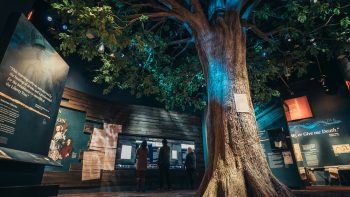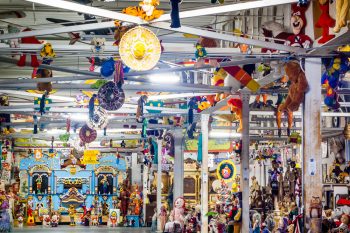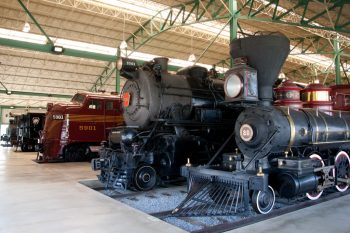By Denny Dyroff, Entertainment Editor, The Times
In the early days of spring when the weather can be very unpredictable, indoor activities are frequently the best options for weekend plans.
With the COVID-19 pandemic having the world in its grip, indoor activities have become a major no-no.
Going to a concert or a sporting event – forget about it.
Having dinner at a restaurant – not right now.
Spending a day appreciating the exhibits in a museum – activity is not available….or is it?
Actually, you can tour a museum exhibit — at your own pace and without having to worry about staying six feet away from everyone else.
The Museum of the American Revolution (www.amrevmuseum.org) is closed to the public through Tuesday, March 31, but you can explore the Museum and its content from anywhere with free digital resources for all ages including a Virtual Museum Tour, a Virtual Field Trip, a rich archive of Read the Revolution book excerpts, and more.
Using the internet, you can check out the Museum’s comprehensive activity plans full of primary sources, high-quality images, and provocative questions.
The highlights of the Museum’s digital resources include:
“Virtual Museum Tour”
Experience the Museum’s award-winning, immersive galleries with this Virtual Museum Tour featuring 360-degree, high-resolution images. Using the virtual tour, explore a 360-degree view of the Museum’s nearly two-story replica of America’s first Liberty Tree; mingle among men and women from the Oneida Indian Nation as they discuss whether to support the British or Revolutionaries; navigate aboard a large-scale replica of an 18th-century privateer ship to discover the war at sea, and more.
“Virtual Field Trip”
Go behind-the-scenes at the Museum with Scholastic’s “Beyond the Battlefield” virtual field trip to the Museum with host Lauren Tarshis, author of the I Survived series of children’s historical fiction novels. Along the way, meet Adrienne Whaley, Senior Manager of K-12 Education, and Matthew Skic, Associate Curator; see real artifacts and documents from the Revolutionary era; learn the stories of two teenagers who actually served during the Revolutionary War; and see the actual tent that George Washington lived in as he traveled with his soldiers.
“Read the Revolution Archives”
The Museum’s popular bi-weekly Read the Revolution e-newsletter offers a curated collection of excerpts from thought-provoking books about the American Revolution. Check out the archive of Read the Revolution excerpts here. And for archived livestreams of the Museum’s Read the Revolution speaker series, including talks by Dr. Stephen Brumwell, Dr. Vincent Brown, and Dr. T.H. Breen.
“Digital Collection”
The Museum has an impressive collection of Revolutionary-era objects, works of art, manuscripts, and printed works. Selected treasures from the collection are now available online, including objects used or owned by General George Washington, a rare canteen marked USTATES, elaborately engraved powder horns, and the first newspaper printing of the Declaration of Independence. Explore the collection here.
According to Dr. R. Scott Stephenson, Museum President and CEO, “In this challenging time, it is imperative that we prioritize the safety of our families and communities. The Museum of the American Revolution is currently closed, but there are many ways to explore our galleries and digital content remotely. While there’s no substitute for experiencing a museum in person and standing in the presence of authentic art and artifacts, virtual exploration is the next best thing.”
The Museum of the American Revolution uncovers and shares compelling stories about the diverse people and complex events that sparked America’s ongoing experiment in liberty, equality, and self-government. Through the Museum’s unmatched collection, immersive galleries, powerful theater experiences, and interactive elements, visitors gain a deeper appreciation for how this nation came to be and feel inspired to consider their role in ensuring that the promise of the American Revolution endures.
Video link for the Museum of the American Revolution — https://youtu.be/TplJrFrpD0A.
Another look at Philly during the era of the American Revolution can be found with a virtual tour offered by the Betsy Ross House (historicphiladelphia.org/betsy-ross-house).
The well-known and loved story of Betsy Ross sewing the first Stars & Stripes is tightly woven into the colorful fabric of America’s rich history. The Betsy Ross House, the birthplace of the American flag, is alive with the sights and sounds of the 18th century.
Another center city destination of interest could be the virtual tours being offered by Philadelphia’s Magic Gardens (www.phillymagicgardens.org)
Philadelphia’s Magic Gardens (PMG) inspires creativity and community engagement by educating the public about folk, mosaic, and visionary art. PMG preserves, interprets, and provides access to Isaiah Zagar’s unique mosaic art environment and his public murals.
 Philadelphia’s Magic Gardens strives to be as accessible as possible to those who are interested in visiting and learning about the venue’s space. This virtual tour offers an option to those who may not be able to visit or may not be able to enter some of the areas of the museum that can only be accessed by stairs.
Philadelphia’s Magic Gardens strives to be as accessible as possible to those who are interested in visiting and learning about the venue’s space. This virtual tour offers an option to those who may not be able to visit or may not be able to enter some of the areas of the museum that can only be accessed by stairs.
If you go to Visit Philadelphia’s website (https://www.youvisit.com/tour/visitphilly), you can be a tourist in the Quaker City without even getting up off the couch.
The organization has links to more than 20 different short virtual tours that provide a great introduction to the city.
The list of links includes Benjamin Franklin Bridge, Race Street Pier, Elfreth’s Alley, Independence Hall Exterior, Independence Mall, Liberty Bell Center, Carpenter’s Hall, Betsy Ross House, National Constitution Center, African American Museum of Philadelphia, National Museum of American Jewish History, Second Bank of the United States, Washington Square,Reading Terminal Market, Avenue of the Arts, Pennsylvania Academy of Fine Arts, Penn Museum, The Franklin Institute, The Barnes Foundation, Schuylkill Riverbanks, Boathouse Row,Fairmount Water Works, and Philadelphia Museum of Art “Rocky Steps” at Philadelphia Museum of Art.
The virtual tour of Valley Forge National Historical Park (https://www.nps.gov/museum/exhibits/valley_forge) honors the site of a turning point in the American Revolution. The great improvements in military discipline and organization learned here by the Continental Army, coupled with French assistance on land and sea, led to final victory and independence.
On December 19, 1777, when Washington’s army marched into camp at Valley Forge, it was tired, cold, ill-equipped, and lacking the training essential for consistent success on the battlefield.
However, with determination and training, the Continental Army under Washington’s leadership emerged from Valley Forge as a disciplined fighting force.
This virtual exhibit and tour illustrate life during the Valley Forge winter by showcasing Valley Forge National Historical Park museum collections and the headquarters occupied by Washington and his officers during the Encampment.
In real life, it would take a 10-minute drive to get from Valley Forge to Oaks. In the virtual world, it takes just a few mouse clicks to get from the scenic park to a museum in Oaks.
The American Treasure Tour Museum (http://americantreasuretour.com/) is the place to visit for anyone interested in pop culture and nostalgia.
The Museum’s virtual tour showcases the collections housed in a former tire factory – collections of life-size clown statues and stuffed animals, political memorabilia, promotional campaigns and movie posters.
Anyone with a sense of fun will love this popular culture museum. Seniors love the nostalgia and the younger generations love the oddities, curiosities, colors and sounds.
If you use your computer to visit Strasburg, you’ll be able to check out two popular railroad-oriented museums in the Lancaster County town. Unfortunately, you will have no access to Whoopie Pies or lavish smorgasbord meals.
The Railroad Museum of Pennsylvania (https://rrmuseumpa.org/about/musviews/) offers more than two dozen 360-degree virtual tours of equipment in the collection, from Pennsylvania Railroad steam and diesel locomotives to passenger coaches and sleeping cars.
The National Toy Train Museum (www.nttmuseum.org) presents a library of videos shot from the engine cabs of many of the toy trains in the collection as they race along the track layouts of the museum.
The Pennsylvania Historical and Museum Commission (http://www.phmc.state.pa.us/portal/communities/archaeology/resources/virtual-tour.html) is committed to education and sharing information about the Commonwealth’s vast and fascinating history. Hundreds of archaeological sites have been excavated in Pennsylvania. Investigations have explored habitation sites representing more than 16,000 years of prehistory, back to the time of the last Ice Age, when wooly elephants and saber-toothed tigers roamed the landscape.
The museum’s virtual tour introduces viewers to The State Museum’s Anthropology and Archaeology Gallery and the incredible variety of cultures that formerly occupied our state. Exhibits illustrate archaeological methods of excavation and artifact analysis as well as the results of over 75 years of research.
To get ready for a visit to the final museum on this list, listen first to this Monty Python song — https://youtu.be/FshU58nI0Ts.
Fortunately, you don’t have to drive all the way out to Tioga County to visit the Pennsylvania Lumber Museum (http://lumbermuseum.org/).
The Pennsylvania Lumber Museum is a fun and educational experience for the entire family. Nestled in the wooded mountains of Potter County, the museum invites visitors to discover the courageous yet reckless spirit of Pennsylvania’s lumbering past while learning to care for the forests of the future.
The Museum’s virtual tour looks at the exhibits and 10-acre campus — including a re-creation of an early 20th century lumber camp.
 With all the gloomy vibes that people are experiencing — from losing income to worrying about how the COVID-19 pandemic will affect them — it seems pretty ironic that today is The International Day of Happiness.
With all the gloomy vibes that people are experiencing — from losing income to worrying about how the COVID-19 pandemic will affect them — it seems pretty ironic that today is The International Day of Happiness.
The International Day of Happiness is March 20 — every year — forever.
The International Day of Happiness was introduced by the General Assembly of the United Nations during 2012 and was celebrated for the first time in 2013. Through seminars and educational tips and tools, the aim is to educate and increase public awareness of the benefits of happiness.
The original idea came from the Kingdom of Bhutan in the Himalayan region of Asia. There, the population is thought by many to be among the happiest in the world due to the holistic approach to life and the amount of importance which is placed on the well-being of people and communities, as much as material wealth.
For everyone, the day is a useful reminder that in general happiness does not necessarily come from buying and consuming, or from being famous or glamorous – but often from friends, family and emotional well-being. Internationally, there are many events and websites in which people may participate.
March 20 has been established as the annual International Day of Happiness and all 193 United Nations member states have adopted a resolution calling for happiness to be given greater priority. It is coordinated by Action for Happiness, a non-profit movement of people from 160 countries, supported by a partnership of like-minded organizations.
World Happiness Day theme 2020 – “Happiness for All” — is all about being happier together. The theme mainly focuses on what we have in common instead of focusing on the things that divide us.
March 20 was chosen for International Day of Happiness for its significance as the March equinox. March equinox is a universal phenomenon for the humankind.
March equinox occurs when the plane of Earth’s equator passes through the center of the Sun’s disk. The spring equinox (also called the March equinox or vernal equinox) marks the astronomical first day of spring in the Northern Hemisphere.
Things you should do on March 20 — smile, share, eat healthily, exercise, be grateful, give back, think positively, spend some time with friends and family, spend some time alone, be mindful, dream, listen to music, be charitable and say “thank you” and mean it. Do what makes you happy.
Also, do what is necessary to make everyone happier – do your part in “flattening the curve.”
And don’t forget — Lava manibus tuis (Latin for “Wash your hands”).











